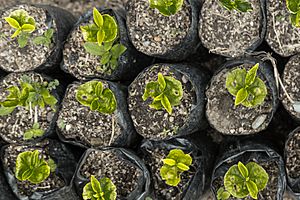Coffee production in Panama facts for kids
Coffee growing in Panama started a long time ago, especially in the beautiful Boquete Valley. Even though coffee plants grew wild across Panama's Pacific coast, people didn't produce enough for everyone in the country at first.
Panama is famous for growing a special kind of coffee called Arabica. This type of coffee is known for its mild and delicious taste. The very best coffee in Panama comes from the Boquete region.
Panamanian coffee has become super popular! In 2008, some coffees from Panama even got higher ratings and sold for more money than coffee from Costa Rica. This is mostly thanks to an amazing type of coffee bean called Geisha. The Geisha coffee plant originally came from Ethiopia, traveled through Tanzania and Costa Rica, and arrived in Panama in the 1960s. But it wasn't until 2004 that people realized how incredibly good it tasted. In 2019, just one pound of Panama Geisha coffee beans sold for an incredible $1029 at an auction!
Where Coffee Grows: Plantations
Most of the coffee grown in Panama is Arabica, about 82 percent. The other 18 percent is another type called Robusta. The best Arabica coffee grows high up in the mountains of the Chiriquí region. These coffee farms are located at elevations between 2,300 and 3,500 feet (about 700 to 1,067 meters) above sea level.
Coffee from these high-altitude farms is known for its sharp, fragrant taste and a mild acidity. Some of the oldest and most respected coffee farms include Café Ruiz. Another famous farm is Café Kotowa, which means "mountain." It was started over 100 years ago by someone from Scotland and makes special, high-quality coffee.
Boquete is home to the largest coffee production factory in Panama. Another important farm is the La Torcaza Estate. It's located on the slopes of Volcan Baru at an elevation of 1,350 meters (about 4,430 feet). This farm grows coffee organically, meaning they use natural methods and tiny helpful organisms to keep the plants healthy.
How Much Coffee Panama Makes
In 2013, Panama produced about 10,100 tons of coffee. This was a small part of the world's total coffee production, about 0.1 percent. Coffee plants were grown on about 22,400 hectares (about 55,350 acres) of land.
Many people in Panama, especially the indigenous groups called Ngäbe and Buglé who live in the Chiriquí and Bocas del Toro areas, rely on coffee farming to support themselves and their families.
The Panamanian government works hard to protect coffee plants from pests. This is because coffee is one of the country's most important crops to sell to other countries. In 2013, some common plant problems that affected coffee farms included Coffee Rust, Ojo de Gallo, and the Coffee Borer Beetle. The government helps farmers deal with these issues to keep the coffee plants healthy and strong.



